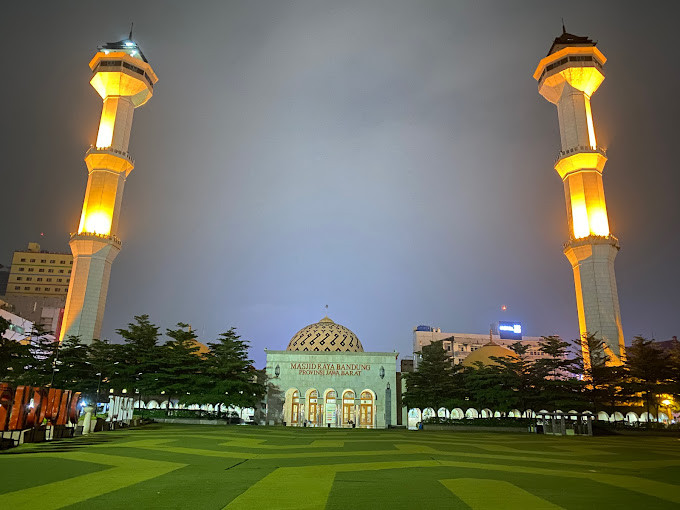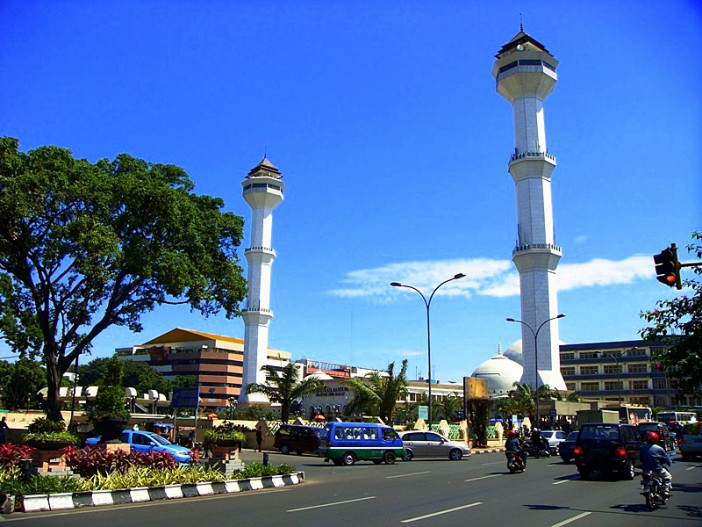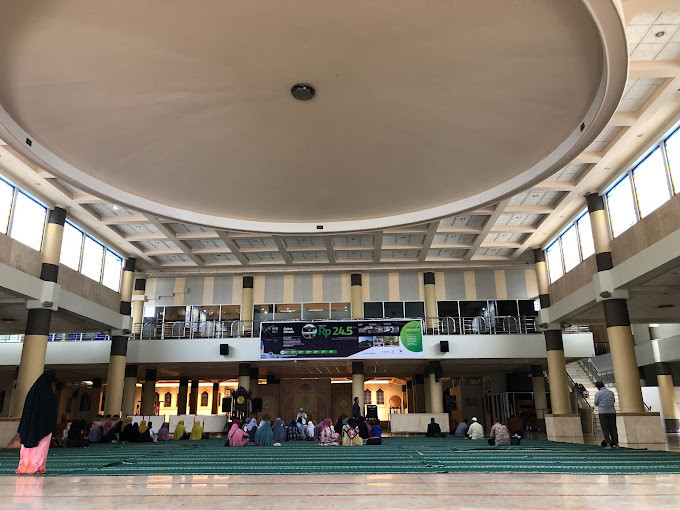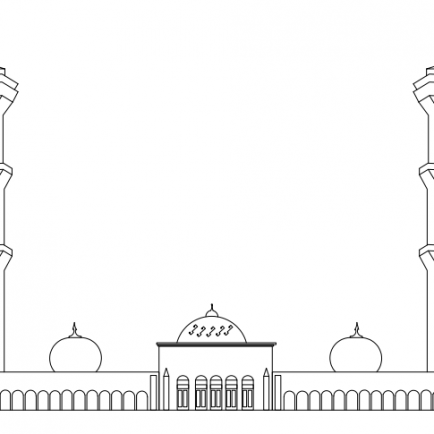Bandung Grand Mosque
History
The Great Mosque of Bandung, West Java, previously named the Great Mosque, was first established in 1812 . The Great Mosque of Bandung was built at the same time as the city center of Bandung was moved from Krapyak, about ten kilometers south of Bandung to the present city center. This mosque was originally built in a simple traditional stilt form, wooden pillars, walls of woven bamboo, thatched roof and equipped with a large pond as a place to take water for ablution. This pond water also functions as a source of water to extinguish the fire that occurred in the Bandung Square area in 1825.
One year after the fire, in 1826 , the mosque building was renovated by replacing the walls of bamboo rooms and the roof with wooden materials. The renovation was done again in 1850 along with the construction of Jalan Groote Postweg (now Jalan Asia Afrika). The small mosque underwent renovation and expansion on the instructions of Regent RA Wiranatakusumah IV. The roof of the mosque was replaced with tiles while the walls were replaced with brick walls.
The grandeur of the Great Mosque of Bandung at that time was even immortalized in a painting by an English painter named W Spreat in 1852. From the painting, it can be seen that the big five-tiered roof is towering and the people call it bale nyungcung . Then the building of the mosque underwent changes again in 1875 with the addition of foundations and fences surrounding the mosque.
Along with the times, the people of Bandung have made this mosque a center for religious activities involving many people such as recitations, Muludan celebrations, Rajaban or other Islamic holiday commemorations and even used as a place for marriage contracts to be held. So that in 1900 to complete it, a number of changes were made, such as making a mihrab and pawestren (terraces on the left and right).
Then in 1930, another renovation was carried out by building a pavilion as the terrace of the mosque and the construction of two minarets on the left and right of the building with a spire that was shaped exactly like the shape of the mosque's roof so that it further enhanced the appearance of the mosque. It is said that this form is the final form of the Great Mosque of Bandung with the uniqueness of the nyungcung-shaped roof.
Towards the Asian-African Conference in 1955, the Bandung Grand Mosque underwent a major overhaul. Based on the design of the first President of the Republic of Indonesia, Soekarno, the Great Mosque of Bandung underwent a total change, including the dome from the previous "nyungcung" shape to a rectangular, Middle Eastern-style dome like an onion.
In addition, the minaret on the left and right of the mosque as well as the pawestren following the front porch were dismantled so that the mosque room was just a large room with a very narrow mosque courtyard. The existence of the Bandung Great Mosque, which was new at that time, was used for prayers for the guests of the Asia-Africa Conference.
The onion-shaped dome designed by Sukarno only lasted about 15 years. After being damaged by a strong wind and having been repaired in 1967, the onion dome was replaced with a non-onion shape again in 1970.
Based on the Decree of the Governor of West Java in 1973, the Great Mosque of Bandung underwent another major change. The floor of the mosque is increasingly being expanded and made terraced. There is a basement room as a place for ablution, the ground floor is the main prayer area and the DKM office and the upper floor is used for the mezzanine which is directly connected to the outer porch. In front of the mosque, a new minaret was built with round metal ornaments like onions and the Joglo-shaped dome roof of the mosque.
Urban and Architectural
The initial design will retain some of the old buildings of the Great Mosque of Bandung, including the bridge that connects the mosque to the main square that crosses the west square and the fish scale-shaped wall in front of the mosque. The only change in the old building is the change in the shape of the roof of the mosque from the shape of a pyramid roof to be replaced with a large hemispherical dome with a diameter of 30 meters which also serves as the main dome.
To reduce the load, the dome is built with space frame construction which is then covered with metal material which is heated at very high temperatures. In addition to the main dome, the Great Mosque of Bandung is equipped with two smaller domes, each with a diameter of 25 meters, placed on top of the additional buildings. Just like the main dome, the two additional domes use space frame construction but are covered with a transparent material to give the effect of light into the mosque.
Additional buildings were erected on land that was previously the west square in front of the mosque. This additional building is equipped with a pair of towers (planned to be 99 meters high ) but later reduced to only 81 meters, related to flight safety as input from the manager of Husein Sastranegara Airport - Bandung. Currently, the two twin towers that flank the main mosque building can be climbed by visitors. On the top floor, floor 19, visitors can enjoy a 360 degree view of the city of Bandung
Meanwhile, the front yard of the mosque was overhauled. Vehicle parking is placed in the basement while the upper part is a park, a public area where people gather. This is one of the city government's efforts to restore the value of Alun-alun to the way it used to be. The basement for the parking lot was originally planned to accommodate street vendors (PKL).
Description
The Great Mosque of Bandung , formerly known as the Great Mosque of is a grand mosque located in the city of Bandung , West Java . The status of this mosque is as a provincial mosque for West Java. This mosque was first built in 1810 and since its founding has undergone 8 renovations in the 19th century, then 5 times in the 20th century until it was finally renovated again in 2001 until the inauguration of the Great Mosque of Bandung on June 4, 2003 which was inaugurated by the Governor of West Java at that time, HR Nuriana. This new mosque, which has an Arabic style, replaces the old Great Mosque, which has a typical Sundanese style .
Bandung Grand Mosque, as we see now, has two twin towers on the left and right sides of the 81 meter high mosque which are always open to the public every Saturday and Sunday. The roof of the mosque was changed from the joglo roof to a large dome on the middle roof and smaller ones on the left and right sides of the roof of the mosque and the walls of the mosque were made of high quality natural stone. Now the total land area of the mosque is 23,448 m² with a building area of 8,575 m² and can accommodate around 13,000 worshippers.
References
https://id.wikipedia.org/wiki/Masjid_Raya_Bandung
https://en.wikipedia.org/wiki/Grand_Mosque_of_Bandung
Details
Location
Bandung , West Java
Worshippers
13000
Owners
Indonesian Mosque Council
Architect Name
Ir. H. Keulman, Ir. H. Arie Atmadibrata, Ir. H. Nu'man and Prof. Dr. Slamet Wirasonjaya
Year of Build
1810
Area
8575
Drawings
Map
History
The Great Mosque of Bandung, West Java, previously named the Great Mosque, was first established in 1812 . The Great Mosque of Bandung was built at the same time as the city center of Bandung was moved from Krapyak, about ten kilometers south of Bandung to the present city center. This mosque was originally built in a simple traditional stilt form, wooden pillars, walls of woven bamboo, thatched roof and equipped with a large pond as a place to take water for ablution. This pond water also functions as a source of water to extinguish the fire that occurred in the Bandung Square area in 1825.
One year after the fire, in 1826 , the mosque building was renovated by replacing the walls of bamboo rooms and the roof with wooden materials. The renovation was done again in 1850 along with the construction of Jalan Groote Postweg (now Jalan Asia Afrika). The small mosque underwent renovation and expansion on the instructions of Regent RA Wiranatakusumah IV. The roof of the mosque was replaced with tiles while the walls were replaced with brick walls.
The grandeur of the Great Mosque of Bandung at that time was even immortalized in a painting by an English painter named W Spreat in 1852. From the painting, it can be seen that the big five-tiered roof is towering and the people call it bale nyungcung . Then the building of the mosque underwent changes again in 1875 with the addition of foundations and fences surrounding the mosque.
Along with the times, the people of Bandung have made this mosque a center for religious activities involving many people such as recitations, Muludan celebrations, Rajaban or other Islamic holiday commemorations and even used as a place for marriage contracts to be held. So that in 1900 to complete it, a number of changes were made, such as making a mihrab and pawestren (terraces on the left and right).
Then in 1930, another renovation was carried out by building a pavilion as the terrace of the mosque and the construction of two minarets on the left and right of the building with a spire that was shaped exactly like the shape of the mosque's roof so that it further enhanced the appearance of the mosque. It is said that this form is the final form of the Great Mosque of Bandung with the uniqueness of the nyungcung-shaped roof.
Towards the Asian-African Conference in 1955, the Bandung Grand Mosque underwent a major overhaul. Based on the design of the first President of the Republic of Indonesia, Soekarno, the Great Mosque of Bandung underwent a total change, including the dome from the previous "nyungcung" shape to a rectangular, Middle Eastern-style dome like an onion.
In addition, the minaret on the left and right of the mosque as well as the pawestren following the front porch were dismantled so that the mosque room was just a large room with a very narrow mosque courtyard. The existence of the Bandung Great Mosque, which was new at that time, was used for prayers for the guests of the Asia-Africa Conference.
The onion-shaped dome designed by Sukarno only lasted about 15 years. After being damaged by a strong wind and having been repaired in 1967, the onion dome was replaced with a non-onion shape again in 1970.
Based on the Decree of the Governor of West Java in 1973, the Great Mosque of Bandung underwent another major change. The floor of the mosque is increasingly being expanded and made terraced. There is a basement room as a place for ablution, the ground floor is the main prayer area and the DKM office and the upper floor is used for the mezzanine which is directly connected to the outer porch. In front of the mosque, a new minaret was built with round metal ornaments like onions and the Joglo-shaped dome roof of the mosque.
Urban and Architectural
The initial design will retain some of the old buildings of the Great Mosque of Bandung, including the bridge that connects the mosque to the main square that crosses the west square and the fish scale-shaped wall in front of the mosque. The only change in the old building is the change in the shape of the roof of the mosque from the shape of a pyramid roof to be replaced with a large hemispherical dome with a diameter of 30 meters which also serves as the main dome.
To reduce the load, the dome is built with space frame construction which is then covered with metal material which is heated at very high temperatures. In addition to the main dome, the Great Mosque of Bandung is equipped with two smaller domes, each with a diameter of 25 meters, placed on top of the additional buildings. Just like the main dome, the two additional domes use space frame construction but are covered with a transparent material to give the effect of light into the mosque.
Additional buildings were erected on land that was previously the west square in front of the mosque. This additional building is equipped with a pair of towers (planned to be 99 meters high ) but later reduced to only 81 meters, related to flight safety as input from the manager of Husein Sastranegara Airport - Bandung. Currently, the two twin towers that flank the main mosque building can be climbed by visitors. On the top floor, floor 19, visitors can enjoy a 360 degree view of the city of Bandung
Meanwhile, the front yard of the mosque was overhauled. Vehicle parking is placed in the basement while the upper part is a park, a public area where people gather. This is one of the city government's efforts to restore the value of Alun-alun to the way it used to be. The basement for the parking lot was originally planned to accommodate street vendors (PKL).
Description
The Great Mosque of Bandung , formerly known as the Great Mosque of is a grand mosque located in the city of Bandung , West Java . The status of this mosque is as a provincial mosque for West Java. This mosque was first built in 1810 and since its founding has undergone 8 renovations in the 19th century, then 5 times in the 20th century until it was finally renovated again in 2001 until the inauguration of the Great Mosque of Bandung on June 4, 2003 which was inaugurated by the Governor of West Java at that time, HR Nuriana. This new mosque, which has an Arabic style, replaces the old Great Mosque, which has a typical Sundanese style .
Bandung Grand Mosque, as we see now, has two twin towers on the left and right sides of the 81 meter high mosque which are always open to the public every Saturday and Sunday. The roof of the mosque was changed from the joglo roof to a large dome on the middle roof and smaller ones on the left and right sides of the roof of the mosque and the walls of the mosque were made of high quality natural stone. Now the total land area of the mosque is 23,448 m² with a building area of 8,575 m² and can accommodate around 13,000 worshippers.








